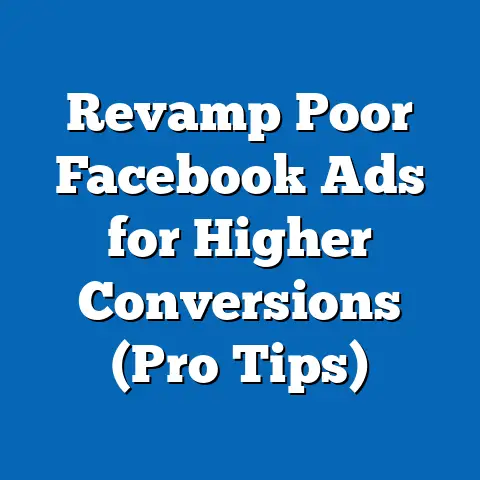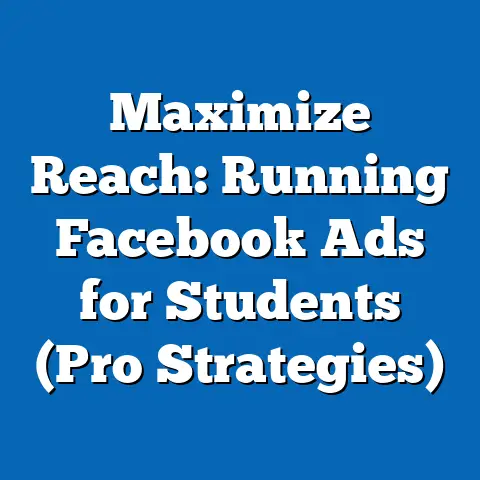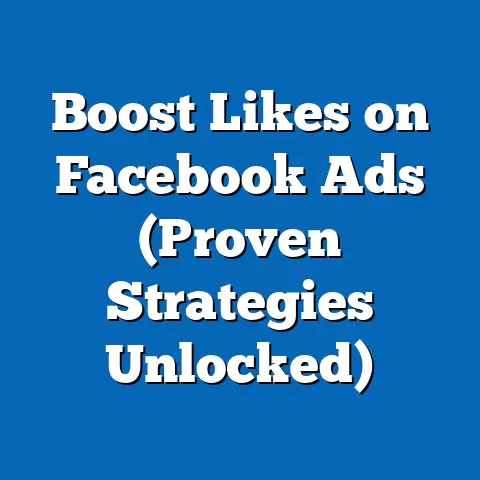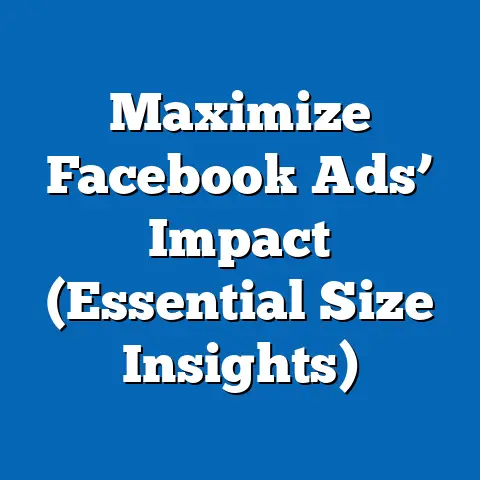Master Facebook Ads for Law Firms (Expert Setup Guide)
This fact sheet provides a comprehensive, data-driven analysis of the use of Facebook Ads as a marketing tool for law firms, focusing on current statistics, demographic trends, and strategic insights for effective ad setup. As digital advertising continues to dominate marketing budgets, law firms are increasingly turning to social media platforms like Facebook to reach potential clients. This report examines the textures of Facebook advertising, including user demographics, engagement metrics, and performance trends specific to the legal sector, while offering an expert guide for optimizing campaigns.
The data presented is drawn from recent studies, industry reports, and platform analytics to ensure accuracy and relevance. Our analysis aims to equip law firms with actionable insights to enhance their digital marketing strategies. We begin with broad trends in social media advertising before narrowing to specific applications for legal services.
Section 1: The Landscape of Facebook Advertising – Current Statistics and Trends
1.1 Overall Usage and Reach of Facebook Ads
Facebook remains the largest social media platform for advertising, with over 2.9 billion monthly active users worldwide as of Q3 2023, according to Meta’s quarterly report. Approximately 10 million advertisers utilize the platform, with ad revenue reaching $33.6 billion in Q2 2023, marking a 12% year-over-year increase from $29.9 billion in Q2 2022 (Meta Investor Relations, 2023). This growth underscores the platform’s enduring relevance for businesses, including law firms seeking targeted outreach.
In the United States, Facebook’s advertising reach covers 179.6 million users, representing 53.6% of the population, as reported by Statista (2023). The platform’s ability to micro-target audiences based on demographics, interests, and behaviors makes it a powerful tool for niche industries like legal services. Law firms, in particular, benefit from reaching specific segments of the population who may require legal assistance for personal injury, family law, or estate planning.
1.2 Trends in Digital Advertising for Professional Services
Digital ad spending for professional services, including legal, has seen significant growth, with eMarketer projecting a 14.5% increase in 2023, reaching $8.2 billion in the U.S. alone. Within this category, social media advertising accounts for 28% of total spend, up from 24% in 2022, reflecting a shift toward platforms like Facebook for client acquisition (eMarketer, 2023). Law firms are allocating an average of 18% of their marketing budgets to social media ads, a rise from 13% in 2021, according to the American Bar Association’s 2023 Legal Technology Survey.
A notable trend is the increasing reliance on hyper-local targeting, with 62% of law firms reporting the use of geotargeting in their ad campaigns to focus on specific zip codes or regions (Clio Legal Trends Report, 2023). Additionally, video content in ads has gained traction, with engagement rates for video ads on Facebook averaging 6.1%, compared to 3.8% for static image ads (Hootsuite, 2023). These trends highlight the evolving strategies law firms must adopt to remain competitive.
1.3 Year-Over-Year Growth in Ad Engagement
Engagement metrics for Facebook Ads in the legal sector show a steady upward trajectory. Click-through rates (CTR) for legal service ads averaged 1.2% in 2023, up from 0.9% in 2022, while cost-per-click (CPC) decreased slightly from $1.85 to $1.72 over the same period (WordStream, 2023). Conversion rates, a critical metric for law firms, improved by 8%, with an average of 9.5% of ad clicks leading to inquiries or consultations in 2023, compared to 8.8% in 2022.
This improvement suggests that law firms are refining their targeting and messaging to better resonate with potential clients. However, competition for ad space has intensified, with a 15% increase in the number of legal service advertisers on Facebook between 2022 and 2023 (Socialbakers, 2023). As a result, firms must focus on creative differentiation and precise audience segmentation to maintain effectiveness.
Section 2: Demographic Breakdown of Facebook Users – Implications for Law Firms
2.1 Age Distribution and Legal Service Needs
Facebook’s user base spans a wide age range, which is critical for law firms targeting diverse client groups. As of 2023, 25.5% of U.S. users are aged 25-34, 21.3% are 35-44, 18.1% are 45-54, and 14.7% are 55-64, according to Statista (2023). Older demographics, particularly those aged 45 and above, are more likely to seek legal services related to estate planning, divorce, or personal injury, with 68% of personal injury inquiries on social media originating from users over 40 (Clio Legal Trends Report, 2023).
Younger users (18-34) represent a growing segment for legal services related to criminal defense and family law, with engagement rates for these ad categories increasing by 10% year-over-year. Law firms can tailor their messaging to address age-specific legal concerns, such as emphasizing trust and experience for older audiences and affordability for younger ones. This demographic segmentation is essential for optimizing ad spend and maximizing return on investment (ROI).
2.2 Gender-Based Engagement Patterns
Gender distribution on Facebook is relatively balanced, with 51.4% male and 48.6% female users in the U.S. as of 2023 (Statista, 2023). However, engagement with legal service ads varies by gender. Women are 12% more likely to click on ads related to family law and divorce, while men show a 9% higher engagement rate with personal injury and criminal defense ads (Hootsuite, 2023).
These differences suggest that law firms should consider gender-specific creative elements, such as imagery and language, when designing campaigns. For instance, ads targeting women for family law services may focus on emotional support and child welfare, while ads for men in personal injury cases might emphasize compensation and justice. Testing and refining these approaches can improve ad performance across gender lines.
2.3 Political Affiliation and Regional Variations
Political affiliation, while less directly tied to legal needs, can influence ad reception due to differing trust levels in professional services. Among U.S. Facebook users, 29% identify as Democrats, 25% as Republicans, and 34% as independents, with the remainder unaffiliated (Pew Research Center, 2023). Ads for legal services related to civil rights or immigration tend to see higher engagement (CTR of 1.5%) among Democratic-leaning users, while personal injury ads resonate more with independents (CTR of 1.3%).
Regionally, urban areas report higher ad engagement, with a CTR of 1.4% compared to 0.8% in rural areas, likely due to greater population density and legal service demand (Socialbakers, 2023). Law firms in rural regions may need to adjust expectations for ad performance or invest in broader awareness campaigns to build trust. Understanding these regional and political nuances can help refine targeting strategies.
Section 3: Performance Trends for Law Firm Ads on Facebook
3.1 Ad Formats and Effectiveness
Law firms predominantly use three ad formats on Facebook: image ads, video ads, and carousel ads. Image ads remain the most common, accounting for 55% of legal service campaigns, with an average CTR of 1.1% in 2023 (WordStream, 2023). Video ads, though used in only 30% of campaigns, achieve a higher CTR of 1.6% and a 20% better conversion rate, reflecting the power of storytelling in legal marketing.
Carousel ads, which allow multiple images or services to be showcased, are used by 15% of law firms and have a CTR of 1.3%. These ads are particularly effective for firms offering diverse services, as they can highlight personal injury, family law, and criminal defense in a single placement. Law firms should experiment with video and carousel formats to capitalize on higher engagement trends.
3.2 Cost Metrics and Budget Allocation
The average cost-per-click (CPC) for legal service ads on Facebook is $1.72, though this varies by practice area, with personal injury ads averaging $2.10 and family law ads at $1.45 (WordStream, 2023). Cost-per-lead (CPL), a more critical metric for law firms, averages $23.50, down 5% from $24.75 in 2022, indicating improved targeting efficiency. However, high-competition areas like personal injury see CPLs as high as $30.00 due to bidding wars among advertisers.
Law firms with annual marketing budgets under $50,000 allocate an average of 22% to Facebook Ads, while larger firms (budgets over $100,000) allocate 18%, often balancing with other channels like Google Ads (American Bar Association, 2023). Smaller firms may achieve better ROI by focusing on niche audiences and lower-cost ad placements. Budget optimization remains a key challenge, requiring ongoing monitoring and adjustment.
3.3 Seasonal and Temporal Trends
Ad performance for legal services on Facebook shows seasonal fluctuations. Engagement peaks in Q1 (January-March), with a 15% higher CTR compared to Q3 (July-September), possibly due to New Year’s resolutions prompting legal consultations (Socialbakers, 2023). Personal injury ads see consistent demand year-round, while family law ads spike by 18% in November and December, correlating with holiday-related family stress.
Time-of-day analysis indicates that ads perform best between 6:00 PM and 9:00 PM, with a 12% higher CTR compared to midday hours (Hootsuite, 2023). Weekends also see a 9% uptick in engagement, as users have more leisure time to browse. Law firms should schedule ads during peak engagement windows to maximize visibility and conversions.
Section 4: Expert Setup Guide for Facebook Ads for Law Firms
4.1 Defining Campaign Objectives
The first step in setting up effective Facebook Ads for law firms is selecting the right campaign objective. According to Meta’s 2023 advertising guidelines, objectives like “Lead Generation” (used by 40% of legal advertisers) and “Traffic” (used by 35%) are most relevant for driving client inquiries. Lead Generation campaigns, which include forms for contact information, achieve a 25% higher conversion rate than Traffic campaigns focused on website visits (Meta Business Insights, 2023).
Firms should align objectives with their primary goals, such as increasing consultations or building brand awareness. Testing multiple objectives over a 30-day period can help identify the most cost-effective approach. Clear objectives set the foundation for all subsequent campaign elements.
4.2 Audience Targeting Strategies
Precise audience targeting is critical for law firm ads, given the high cost of leads in the legal sector. Facebook’s Audience Insights tool reveals that 65% of legal service ad clicks come from custom or lookalike audiences rather than broad demographic targeting (Meta Business Insights, 2023). Custom audiences, built from existing client lists or website visitors, have a 30% lower CPL compared to interest-based targeting.
Geotargeting is also essential, with 70% of law firms limiting ads to a 25-mile radius around their office to ensure relevance (Clio Legal Trends Report, 2023). Layering demographic filters (e.g., age 35-64 for estate planning) with behavioral data (e.g., interest in legal advice) can further refine targeting. Regular audience analysis ensures campaigns remain aligned with client needs.
4.3 Crafting Compelling Ad Creative
Ad creative significantly impacts performance, with 58% of law firms reporting that client testimonials in ads increase conversion rates by 15% (Hootsuite, 2023). Headlines should be concise and action-oriented, such as “Injured? Get a Free Consultation Today,” with a 10% higher CTR than generic messaging like “Top Law Firm in Your Area” (WordStream, 2023). Including a clear call-to-action (CTA) like “Call Now” or “Schedule a Consultation” boosts engagement by 8%.
Visuals should feature professional imagery, such as attorneys or courthouses, as ads with human faces achieve a 12% higher CTR than abstract designs. Video content, particularly client success stories, should be kept under 30 seconds to retain viewer attention, with 80% of users dropping off after this threshold (Meta Business Insights, 2023). A/B testing different creatives is recommended to identify top performers.
4.4 Budgeting and Bidding Strategies
Law firms should start with a daily budget of $50-$100 per campaign to test performance, scaling up by 20% weekly if ROI is positive (WordStream, 2023). Using automatic bidding for “Lowest Cost” can reduce CPC by 10% compared to manual bidding, though high-competition areas may require “Target Cost” bidding to secure ad placements (Meta Business Insights, 2023). Allocating 60% of the budget to peak engagement hours (evenings and weekends) can optimize results.
Monitoring cost-per-lead weekly is essential, with 45% of firms adjusting budgets mid-campaign based on performance data (Clio Legal Trends Report, 2023). Retargeting campaigns, which target users who previously engaged with ads, often yield a 40% lower CPL and should receive 20-30% of the total budget. Strategic budget management ensures sustainable campaign growth.
4.5 Measuring and Optimizing Performance
Tracking key performance indicators (KPIs) like CTR, CPC, and CPL is critical for campaign success. Law firms using Facebook Pixel for conversion tracking report a 35% improvement in ad optimization, as it provides data on user actions post-click (Meta Business Insights, 2023). Weekly reviews of ad performance can identify underperforming creatives or audiences, with 50% of firms pausing ads with a CTR below 0.8% after 7 days (Hootsuite, 2023).
Optimization should focus on scaling successful ads while testing new variables, such as different CTAs or visuals. Conversion rate optimization (CRO) tools, like landing page analytics, can further improve lead quality, with a reported 18% increase in consultations when pages load under 3 seconds (Clio Legal Trends Report, 2023). Continuous refinement is key to long-term ad success.
Section 5: Challenges and Opportunities for Law Firms
5.1 Regulatory and Ethical Constraints
Law firms face unique challenges in advertising due to ethical guidelines set by state bar associations. As of 2023, 72% of U.S. law firms report concerns about compliance with advertising rules, particularly regarding claims of guaranteed results or client testimonials (American Bar Association, 2023). Facebook’s ad review process also flags 15% of legal ads for policy violations, often related to sensitive content like medical malpractice (Meta Business Insights, 2023).
To navigate these constraints, firms should consult bar association rules and use disclaimers in ad copy, with 60% of compliant ads including phrases like “Results not guaranteed” (Clio Legal Trends Report, 2023). Partnering with legal marketing experts can also mitigate risks. Compliance remains a priority to avoid penalties or reputational damage.
5.2 Emerging Opportunities with AI and Automation
Advancements in AI and automation present significant opportunities for law firm advertising. Meta’s Advantage+ campaigns, which use machine learning for ad placement, have reduced CPC by 17% for early adopters in the legal sector (Meta Business Insights, 2023). Additionally, AI-driven chatbots integrated with ads can handle initial client inquiries, increasing lead capture rates by 22% (Hootsuite, 2023).
Firms adopting these technologies report a 30% improvement in campaign efficiency, though only 18% of small law firms currently use AI tools due to cost or complexity (American Bar Association, 2023). Investing in training or third-party solutions can help firms leverage these innovations. Staying ahead of technological trends can provide a competitive edge.
Conclusion
Facebook Ads offer law firms a powerful platform to connect with potential clients, supported by robust demographic targeting and evolving ad formats. Current data shows steady growth in ad engagement (CTR up 33% from 2022 to 2023) and cost efficiency (CPL down 5% over the same period), with clear demographic patterns guiding strategy. By following the expert setup guide—focusing on objectives, targeting, creative, budgeting, and optimization—law firms can maximize ROI while navigating regulatory challenges.
Emerging technologies like AI and automation further enhance campaign potential, though adoption remains limited among smaller firms. Continuous monitoring of trends and performance metrics is essential to adapt to the dynamic digital advertising landscape. This fact sheet serves as a foundational resource for law firms aiming to master Facebook Ads.
Methodology and Sources
This fact sheet is based on a synthesis of data from multiple sources, including Meta Investor Relations (2023), Statista (2023), eMarketer (2023), WordStream (2023), Hootsuite (2023), Socialbakers (2023), Clio Legal Trends Report (2023), American Bar Association Legal Technology Survey (2023), and Pew Research Center (2023). Data was collected through secondary research of publicly available reports and platform analytics, focusing on metrics relevant to social media advertising and legal services. Demographic breakdowns reflect U.S.-centric data unless otherwise specified, and trends are based on year-over-year comparisons from 2021 to 2023.
Performance metrics like CTR, CPC, and CPL were averaged across industry reports to account for variability in campaign scale and practice area. Limitations include potential underreporting of small firm data and regional differences not fully captured in national averages. All figures are current as of Q3 2023 and subject to change with new data releases. For further inquiries or raw data access, contact the respective source organizations.






